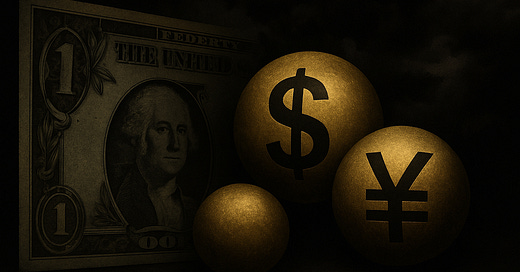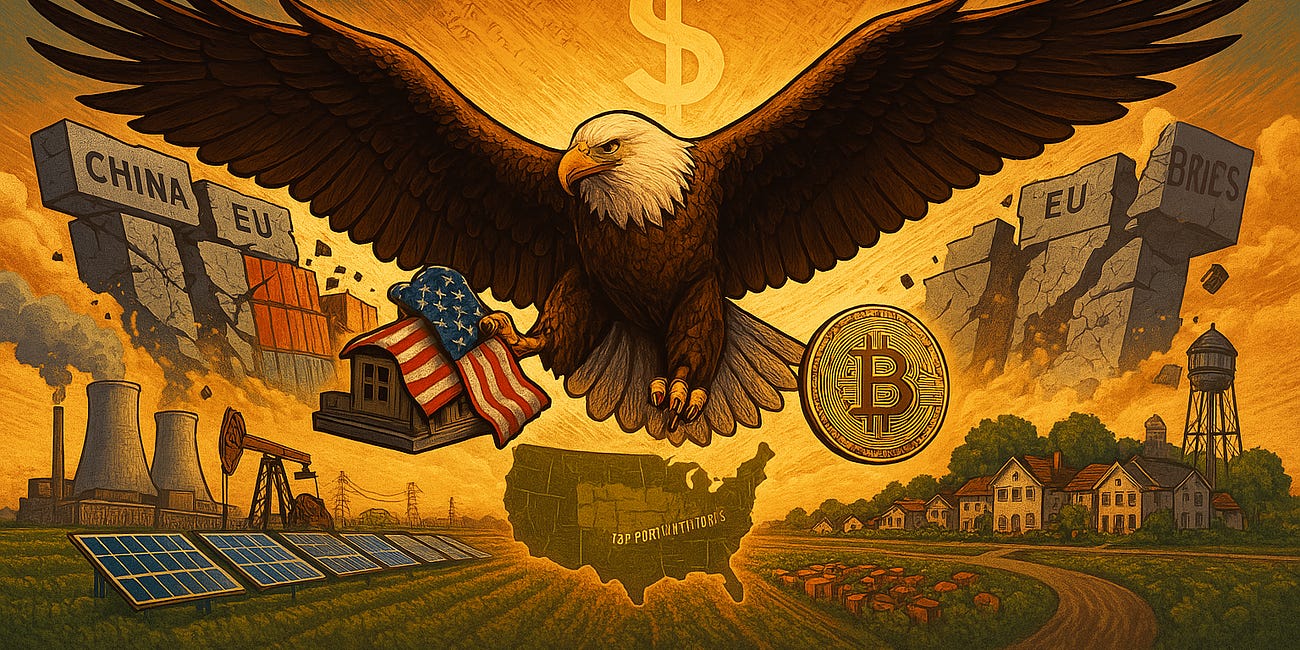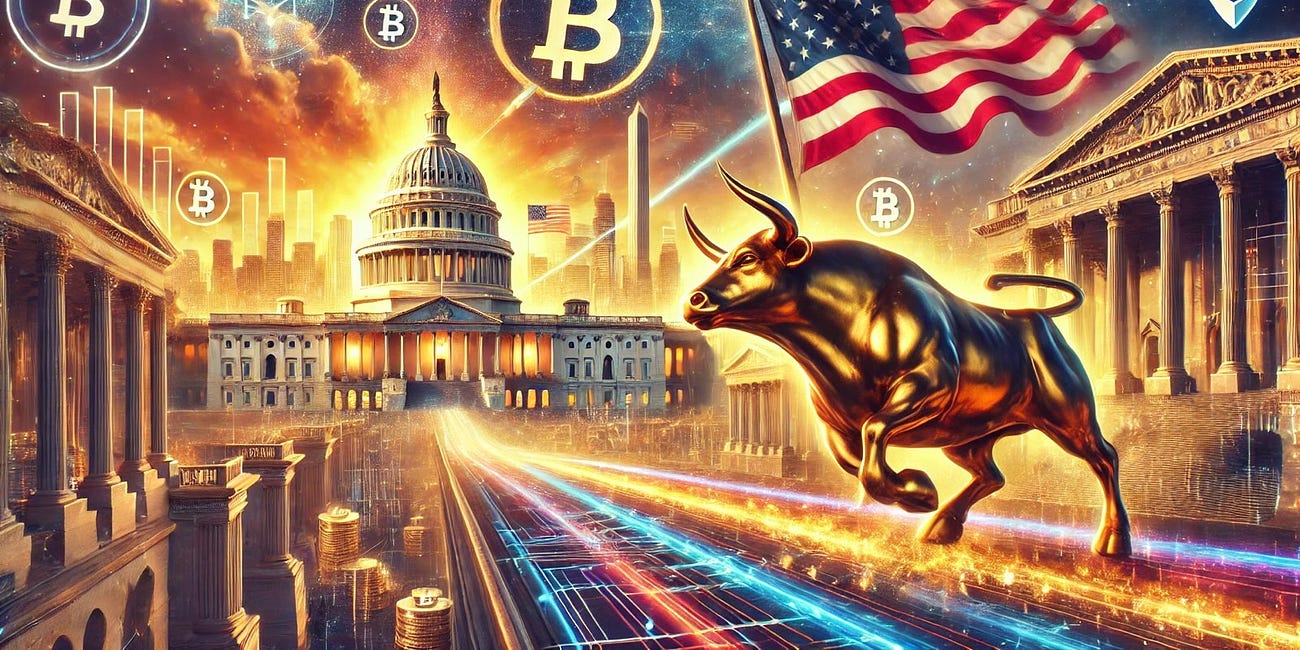The Dollar Won’t Die Quietly: Inside the Messy Truth About Global Currency Power
Zoom In on Historical Context to Zoom Out on the Reality of Present Day Global Trade.
Every few minutes these days, headlines ignite panic over the imminent “end of the U.S. dollar.” From the BRICS bloc creating alternative payment rails to China settling trades in yuan, the narrative of “de-dollarization” is gaining emotional momentum. This has been amplified this past week with the abnormal move of dollar weakness with a simultaneous spike in 10Y Treasury yields.
But behind the headlines, geopolitical posturing, and inflammatory rhetoric, there’s a long arc of history, structural economic realities, and fundamental truths about how monetary systems actually work.
In short: The truth is more complex—and far less apocalyptic.
Today, I want to explore what real currency failure looks like, why the U.S. dollar is unlike any currency that’s failed before, whether Bitcoin is a viable replacement, and — most importantly —what it all means for retail investors and retirees trying to preserve wealth and peace of mind in an unstable world.
What Causes a Currency to Collapse?
Currency failure isn’t just about inflation or policy missteps. It’s a systemic breakdown. These are the common patterns:
Hyperinflation: When money printing exceeds productivity and public confidence vanishes (e.g., Zimbabwe 2008).
Loss of Trust: Chronic debasement (e.g., Roman Denarius) erodes long-term credibility.
Collapse of Government: Without enforcement, money becomes worthless (e.g., the Confederate Dollar).
Transition by Design: Some currencies phase out through supranational shifts (e.g., Greek Drachma to Euro).
These currencies usually fail within fragile, isolated economies—not globally dominant ones.
The Dollar Is Built Differently
The U.S. dollar is not just another fiat currency. It is:
The world’s reserve currency, held in over 60% of global foreign reserves.
The basis for international debt markets, including sovereign and corporate borrowing.
The default medium of exchange for most cross-border trade.
It is the operating system and source code of the most interconnected global economy in the history of humanity. Read more on that in my recent piece here
Its strength isn’t just about faith in America—it’s about architecture.
From Wall Street liquidity to petrodollar contracts, the dollar is hard-coded into the world’s economic operating system. A collapse wouldn’t just affect the U.S.—it would ripple across every country, commodity, and corporation tied to it. For more on the pain it would cause to switch check out
for incredible depth on this topic and the Dollar Milkshake TheoryWhat Happens If the Dollar Fails?
A hypothetical dollar collapse wouldn’t just be a currency story—it would be a civilizational event.
Liquidity Crisis: Global credit markets would freeze. Nobody could price risk.
Sovereign Defaults: Countries reliant on dollar-denominated debt would face soaring costs and widespread defaults.
Trade Chaos: With contracts voided and pricing mechanisms gone, trade networks would seize up.
Social Instability: As seen in past collapses (Argentina, Weimar Germany), economic failure leads to unrest and extremism.
This isn’t a smooth transition to “the next thing”—it’s a potential descent into chaos.
Why Bitcoin (Probably) Isn’t the Replacement
Despite its growing adoption and my personal love for it, Bitcoin is unlikely to replace the dollar (despite Larry Fink’s recent rhetoric), though it may be the perfect complement to it. Here's why:
Challenges
Scalability: Bitcoin's network cannot currently support the sheer volume of global transactions. The maturity of its Layer2 solutions is still in the early days, needing another decade to evolve and mature.
Government Resistance: No major sovereign entity has yet voluntarily ceded monetary control to its decentralized algorithm. However, smaller countries from El Salvador to Argentina have become powerful pilots of a Bitcoin Strategic Reserve, and the U.S. is in the driver’s seat to add the Bitcoin Plug-in to its current hegemonic source code to tip these scales of adoption
Advantages
Scarcity: Its 21-million cap prevents inflation via overprinting.
Decentralization: BTC provides a censorship-resistant alternative during crises.
Store of Value to Global Settlement Layer for RWAs: Bitcoin may become the “digital gold” of the 21st century, but its lesser-known strength is that it has the ultimate advantage of blockchain networks to win the global settlement layer for all tokenized real-world assets (RWAs) in the near future.
But again, these things take time, and governments are in no hurry to cede control of the global reserve unit of account to a permissionless ledger and currency when it’s not as easy to manipulate as a sovereign fiat currency.
The Long Arc of Currency Dominance
Let’s not forget: the U.S. dollar already replaced a global currency—the British Pound Sterling. But that transition took decades, two world wars, and the creation of global institutions like the IMF and World Bank.
Dutch Florin → British Pound (18th century)
British Pound → U.S. Dollar (20th century)
Next? The end of dollar dominance won’t come fast—it will come through consensus, crises, and coordinated infrastructure change over decades.
The most realistic future? Bitcoin as a complementary reserve asset, not a global reserve currency.
Conclusion: A False Binary
Framing the conversation as "Dollar vs. Bitcoin/Yuan/Gold" is overly simplistic. A more accurate understanding sees the dollar evolving — not disappearing — with parallel systems like Bitcoin acting as circuit breakers during crises.
De-dollarization isn’t impossible. But in a global economy wired for USD, any shift will be slow, messy, and dangerous to accelerate.
The more realistic threat isn’t de-dollarization, it’s mismanagement of the dollar’s power by U.S. policymakers themselves.
🧨 What Does “Mismanagement of the Dollar’s Power” Actually Mean?
When we say, “It’s mismanagement of the dollar’s power by U.S. policymakers themselves,” we’re pointing to the irresponsible use of the dollar’s global dominance — like a trust fund heir burning through their inheritance without realizing the rest of the family depends on it.
Here’s how that mismanagement manifests:
1. Weaponizing the Dollar Through Sanctions Overreach
Excessive use of financial sanctions and dollar-clearing bans against foreign nations pushes countries to explore alternative currency systems (BRICS, CBDCs, barter, etc.).
It undermines global trust in the dollar's neutrality as a trade settlement layer, especially in energy and commodities.
“You can either be the global reserve currency or the global economic enforcer — not both forever.”
2. Fiscal Recklessness
Running unsustainable deficits and amassing $34+ trillion in national debt without a long-term repayment strategy reduces global confidence. This is why a move toward a balanced budget and D.O.G.E. is so crucial.
Monetizing that debt via excessive quantitative easing creates inflationary pressure, weakening purchasing power at home and trust abroad.
3. Yield Curve Instability and Treasury Volatility
Erratic debt issuance and policy communication create interest rate volatility, which spills over into emerging markets, credit markets, and global liquidity.
4. Neglecting the Dollar’s Role in Global Coordination
The U.S. often fails to build multilateral trust and infrastructure around dollar systems (e.g., cross-border payment rails, swap lines) to secure its role for the long haul.
Instead of strengthening international buy-in, U.S. policy often assumes dollar dominance is permanent and doesn’t need stewardship.
✅ What Would Proper Management of the Dollar’s Power Look Like?
Think of the dollar as the operating system of global finance. Good management means upgrading the system, reducing security vulnerabilities, and inviting other users to help govern the protocol without undermining its integrity.
Here’s what that looks like in practice:
1. Restore Fiscal Discipline Without Austerity
Control deficit growth, reduce reliance on debt-funded stimulus, and ensure investments (not entitlements) dominate future spending.
Signal credibility with long-term repayment plans and structural reforms.
2. Use Sanctions and Tariffs Like a Scalpel, Not a Sledgehammer
Deploy financial sanctions strategically and multilaterally, rather than unilaterally or excessively.
Protect the dollar’s role as a neutral reserve asset, not just a tool of U.S. foreign policy.
3. Support a Healthy Treasury Market
Maintain liquidity and buyer confidence in Treasury auctions by coordinating with the Fed and primary dealers.
Ensure stable issuance patterns and transparent policy guidance to avoid crowding out private capital or triggering yield spikes.
4. Lead in Global Dollar Infrastructure Innovation
Modernize dollar settlement through stablecoin regulation, FedNow, or blockchain-based clearing rails.
Encourage the development of compliant, fast, cross-border dollar systems before China fills the void with digital yuan solutions.
5. Incorporate Bitcoin and Hard Assets into Strategic Reserves (Carefully)
Consider holding a small percentage of Bitcoin or gold as a volatility hedge or geopolitical stabilizer. Pass the Bitcoin Act and the Genius Act through Congress.
Promote the dollar’s evolution, not its replacement, by making space for parallel systems that increase resilience.
🧭 Bottom Line
The dollar isn’t at risk because others are attacking it — it’s at risk because we’ve taken its dominance for granted.
Proper management means protecting the dollar not just through military strength or trade deals — but through credible economic policy, global trust, and future-proof infrastructure.
If we treat dollar dominance like a privilege that must be earned— not a right to be exploited — it can remain the backbone of global finance for generations.
So What Should a Concerned Retail Investor Actually Do?
Let’s bring it home now to your kitchen table.
If you’re a prudent investor trying to secure your future in a volatile world, here’s what all this means:
1. Don’t Fall for Panic
Headlines about “the death of the dollar” are emotionally charged but economically lazy. The dollar isn’t disappearing tomorrow, and de-dollarization is a multi-decade geopolitical chess match, not a sprint.
2. Diversify—But With Purpose
Build a portfolio that respects global uncertainty without betting the farm on doomsday:
Keep core allocations to U.S. stocks and bonds.
Add real assets like real estate and commodities.
Include Bitcoin or gold as insurance policies—not the whole plan.
3. Focus on Cash Flow and Optionality
Whether it’s dividend-paying stocks, income-producing property, or short-duration private credit, look for assets that pay you to wait and offer flexibility.
4. Prepare for a Shift, Not a Collapse
Don’t prepare for the end of the dollar. Prepare for a world where the dollar is joined by digital currencies, strategic reserves, and decentralized assets. It’s not a funeral—it’s a remix.
Clarity Is a Better Hedge Than Fear
Yes, we live in volatile times. But history reminds us: global currencies don’t die easily — and when they do, they don’t go alone.
Stay calm. Stay diversified. Think decades — not days.
~Chris J Snook
Sources:
A Short History of Major Fiat Currency Collapses | Bitcoin.com
Why Bitcoin Will Not Replace the Dollar | Advisor Perspectives






